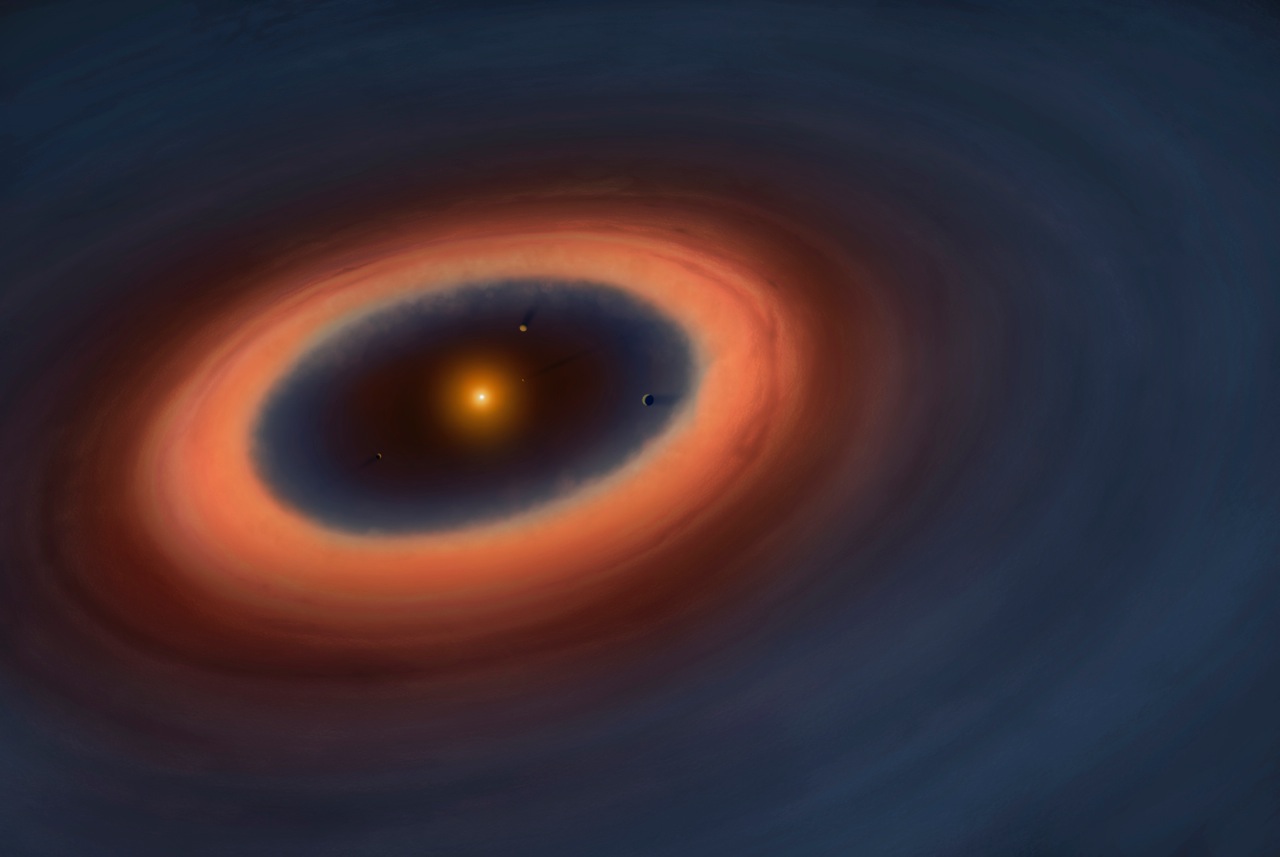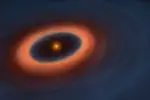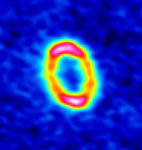ALMA confirms predictions on the interaction between protoplanetary disks and planets
New observations made with the Atacama Large Millimeter/submillimeter Array (ALMA) of the disk that surrounds a young star, less massive than the Sun, confirm theories about the interaction between recently formed planets and disks. A team of astronomers led by Héctor Cánovas from Universidad de Valparaíso and the Millennium ALMA Disk Nucleus (MAD) observed the dust ring possibly sculpted by planets in formation around the star Sz 91, at a distance roughly 650 light years from Earth.
The results obtained show the first disk around a star that is less massive than ours - it has only half of the mass of our Sun - which simultaneously presents a migration of dust particles from the outermost zones and evident signs of interaction between young planets with the disk in the innermost zone.
Planets are born in dust and gas disks that surround young stars and feed them with matter, leaving a “footprint” of this interaction in the structure of the disk. The theoretical models that study this interaction predict that the giant planets carve the protoplanetary disk, creating a “hole” in the innermost part of the disk, and preventing mm-sized dust particles (like grains of sand on a beach) from continuing their journey towards the central star. At the same time, dust particles in the outermost parts of the disk (the farthest from the star) are moving inward by the combined action of gravity and aerodynamic forces (gas-drag).
The combination of all these effects is expected to create an accumulation of dust at the edge of the hole. As a consequence, a sharp ring maybe seen in the emission of disks that host recently formed giant planets. This is what ALMA observed.
“The sharp image from ALMA shows a ring around the young star. And it is a surprisingly large ring, over three times the size of Neptune's orbit (a radius of approximately 110 astronomical units (AU)” explains Héctor Cánovas.
The image from ALMA only shows the ring, as the radio telescope detects the cold dust particles that make it up, and not the planets and the star, as these are primarily made up of hot gas.
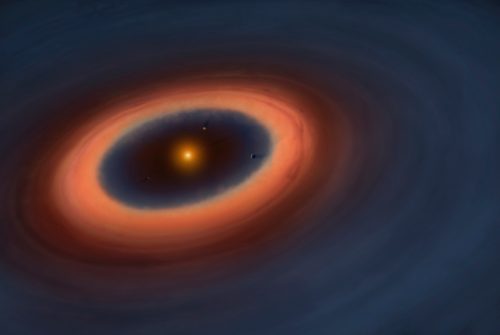
Artistic illustration of the Sz 91 system. The blue color represents the gas in the disc, which extends far beyond the dust ring and is also detected inside the ring. Credit: ALMA (ESO/NAOJ/NRAO), Mark Garlick
“Based on the current paradigm of planet-disk interactions, only giant planets orbiting the innermost parts of the disk can explain the presence of a ring with such a large radius,” indicates Antonio Hales, ALMA astronomer and member of the research team.
The accumulation of dust particles in a narrow annular structure, as is the case with Sz91, can favor the formation of more planets, because the high density of dust particles in the ring would provide the ideal conditions for the dust particles to agglutinate and grow in size until they form small planetary nuclei.
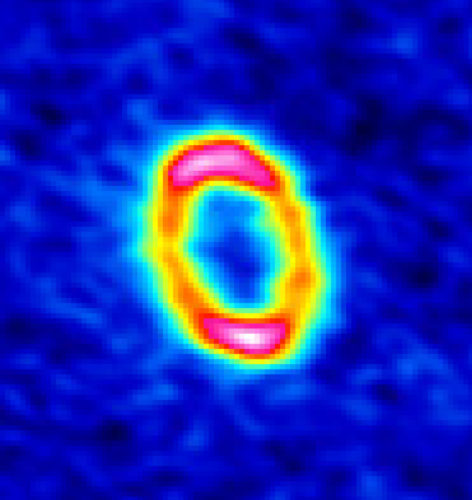
Image taken by ALMA of the dust ring that surrounds the young star Sz 91. This ring is primarily made up of mm-sized dust particles. The interaction between several recently formed planets and the protoplanetary disk that still surrounds the star probably generate the dust ring observed by ALMA.
“The results of this investigation show that Sz91 is a highly important protoplanetary disk for the study of planetary formation, planet-disk interactions, and the evolution of these disks around stars of lower mass, as Sz91 shows evidence of all these processes simultaneously,” concludes Matthias Schreiber, coauthor of the study.
Additional information
This investigation was presented in an article entitled “A ring-like concentration of mm-sized particles in Sz 91”, written by Héctor Cánovas and collaborators, which will soon be published in the specialized journal Monthly Notices of the Royal Astronomical Society (MNRAS).
The research team is made up of Héctor Cánovas, Claudio Cáceres, Matthias Schreiber, Adam Hardy (all from Universidad de Valparaíso and from the Millennium ALMA Disk Nucleus (MAD), Chile), Lucas Cieza (Universidad Diego Portales and MAD, Chile), Francois Ménard (UMI, CNRS and Universidad de Chile) and Antonio Hales (JAO-ALMA, Chile).
The Atacama Large Millimeter/submillimeter Array (ALMA), an international astronomy facility, is a partnership of the European Organisation for Astronomical Research in the Southern Hemisphere (ESO), the U.S. National Science Foundation (NSF) and the National Institutes of Natural Sciences (NINS) of Japan in cooperation with the Republic of Chile. ALMA is funded by ESO on behalf of its Member States, by NSF in cooperation with the National Research Council of Canada (NRC) and the Ministry of Science and Technology (MOST) in Taiwan and by NINS in cooperation with the Academia Sinica (AS) in Taiwan and the Korea Astronomy and Space Science Institute (KASI).
ALMA construction and operations are led by ESO on behalf of its Member States; by the National Radio Astronomy Observatory (NRAO), managed by Associated Universities, Inc. (AUI), on behalf of North America; and by the National Astronomical Observatory of Japan (NAOJ) on behalf of East Asia. The Joint ALMA Observatory (JAO) provides the unified leadership and management of the construction, commissioning and operation of ALMA.
Link
Contacts
Héctor Cánovas
Universidad de Valparaíso Valparaíso, Chile
Tel: +56 032 - 299 5555
Tel: +56 02 84144232
E-mail: [email protected]
Valeria Foncea
Education and Public Outreach Officer
Joint ALMA Observatory
Santiago, Chile
Tel: +56 2 467 6258
Cell: +56 9 75871963
E-mail: [email protected]
Charles E. Blue
Public Information Officer
National Radio Astronomy Observatory
Charlottesville, Virginia, USA
Tel: +1 434 296 0314
Cell: +1 202 236 6324
E-mail: [email protected]
Richard Hook
Public Information Officer, ESO
Garching bei München, Germany
Tel: +49 89 3200 6655
Cell: +49 151 1537 3591
E-mail: [email protected]
Masaaki Hiramatsu
Education and Public Outreach Officer, NAOJ Chile
Observatory
Tokyo, Japan
Tel: +81 422 34 3630
E-mail: [email protected]
